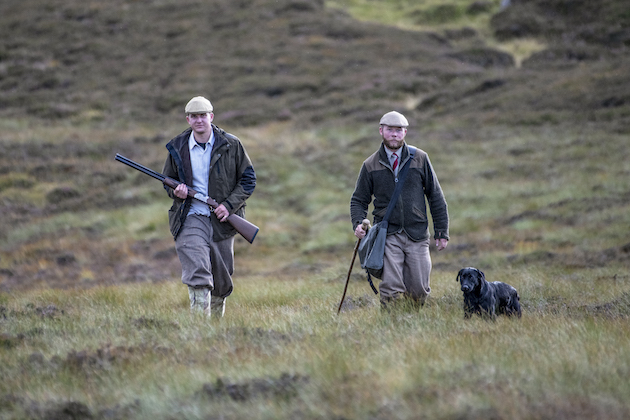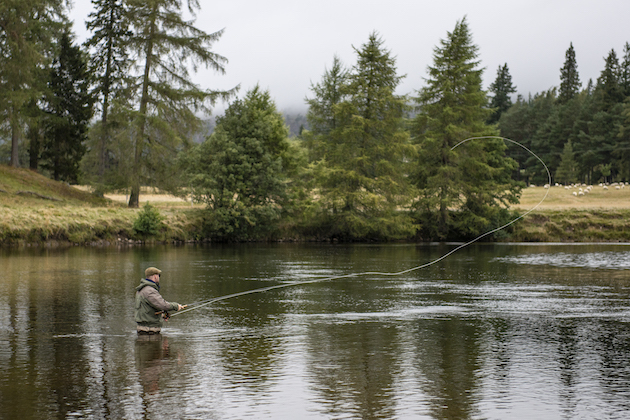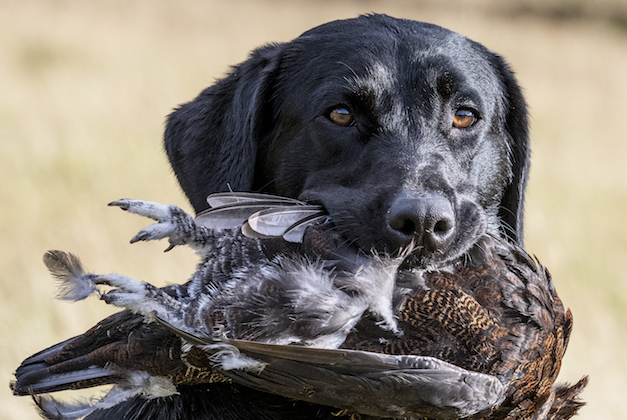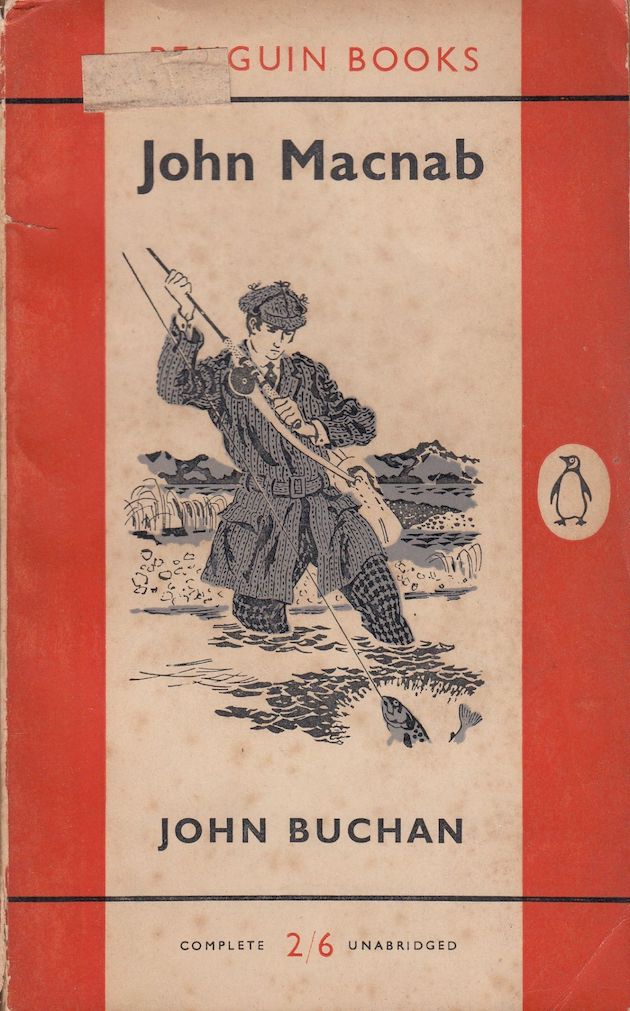Win CENS ProFlex DX5 earplugs worth £1,149 – enter here
Going for a Macnab

Better luck next time,” the stalker said to me, patting my shoulder, as I watched the winded stags gallop away over the hill.
That had been my second attempt at bagging a Macnab and I had failed. The previous occasion had seen me catch a fish before breakfast, grass a stag in the early afternoon and then fail on the grouse at sunset.
I cursed my luck and headed back down the glen to the lodge, where I spent the evening sulking in front of the fire with a glass of Talisker.
In 1925 literary great John Buchan wrote the sporting classic John Macnab, in which a cabinet minister, a banker and a barrister attempt to cure their boredom by warning three Highland estates that within 48 hours they will poach a salmon and two stags from each.
The classic version of a Macnab nowadays — for legal reasons most likely — is to catch a salmon on the fly, shoot a stag and bag a brace of grouse, too, in just 24 hours. You may have heard tales of southern sorts claiming that they, too, have achieved a Macnab with some combination of snipe, sea trout and roe, but you wouldn’t catch me drinking with those charlatans.
It was mid-October and I was sipping a rather-too-warm whisky and looking out of the plane window as it propelled me north for my third attempt at a Macnab. “Third time lucky,” I muttered as I spotted the River Dee carving its way across the Highlands.
Touching down at Aberdeen airport, I jumped into the car that would take me to Braemar. The Scottish taxi driver — seemingly a keen fisherman — started giving me river reports. “There’s not many fish in the Dee,” he said sadly. “You could once cast a line and you would have had a 12-pounder easily, but you never know,” he continued, “there’s always a chance.”
We pulled up to our hotel who would be hosting me, The Fife Arms. The hotel had recently been refurbished and reopened in January with the goal of becoming more fieldsports-orientated.
From the moment I walked in I was reminded of the house filled with stags’ heads I visited every summer in Scotland when I was a child.
At the bar, over a rather better whisky, I met Ben Carter, the hotel’s director of wild resources, who was going to be my guide.
“We will be trying for the salmon first,” he explained. “As soon as we get that then it should be pretty simple to bag the rest of the Macnab. That way round is the easiest way to complete it nowadays.” Easier said than done, I thought — particularly when this man had never seen me cast a line or fluff going-away shots as I am often wont to do.
To complete a Macnab you do need a certain amount of skill, preparation and a guide who really seems to know their stuff. I have also always found that wandering the river the day before the attempt, to learn where the fish lie and even practise your casting, is very useful.
The time of year is also important for attempting a Macnab. It is certainly the case that my journey north was a little later in the year than many people might think of as ‘classic Macnab time’. This was all part of my plan — I think holding off until September or October, when the stags become more focused on the rut than their safety, and it can be easier to get a salmon on a river with a late run, really increases the odds of success.

Casting on the Keppoch pool in the early morning light is textbook Macnab, if the fish bites
Nowadays, as Ben said, you should always go for the fish first. The elusiveness of this quarry makes it the most difficult out of the three. If you’re a deep-pocketed sort, spending a week fishing every morning will really maximise your chances of getting into a fish, at which point you can then go after the birds and the beast.
The sun was just starting to rise over Deeside when I cast my first fly out across the Keppoch pool. With the river being lower than usual I started with a small Cascade fly on a floating line and was buoyed by a fish of about 6lb jumping in front of me. I immediately flung the line across to where it had leapt and stripped furiously back but nothing took.
I changed to an Executioner and moved onto the tail of the pool. There was a deep eddy behind a large rock at the end, where I believed a fish might be holding. I cast the fly and made a figure of eight to bring it in, creating a rhythmic motion through the water.
This yielded no interest so I then slowed the pace of the fly by mending the line, causing it to sink a bit deeper, which provoked a tug from the middle of the river. My heart leapt and I tried again in the same place. As the fly disappeared through the water column, the fish grabbed at it and took me for a ride of about five feet before spitting it out.
I shouted, listened to the noise echo back from the riverbank opposite and then cast again. For another three hours, I fished on down the beat fruitlessly. Unsurprisingly, the fish avoided all attempts and a shout from the bank from Ben when I was pausing for coffee told me we had to move on to the grouse.
Without the fish to start you off puts you at a massive disadvantage for the challenge. All you can hope for is quick success on the hill and then to get out on the river again to winkle out a fish, before it’s back to the lodge for tea and medals. That was what the optimist in me was saying, anyway.
A six-pointer stag with switch antlers
I would have preferred to go for the stag before the grouse. With my accuracy skills it would take at least a ratio of 3:1 before I can connect to a bird and with those six bangs, the stags would have probably moved off across the hill. That said, however, a successful Macnab attempt relies on you trusting the keepers and ghillies as they know the landscape and always have Plans A-Z up their sleeves.
As we drove up a winding track the Scots pines fell away and I was greeted with purple and green moorland. The wind was light with little chance of rain. I met Richard Thomas, headkeeper of the fabled Invercauld Estate, by the remote lunch hut.
Given my non-existent gym routine, the walking was tough going and after 15 minutes, when a grouse got up in front of me cackling furiously, I fluffed the shot. George Duff, another keeper on the estate, consoled me. “Don’t worry about it,” he said.
“It’s not so much about the accuracy, it’s the appreciation of where you are. I’m lucky to be looking at this landscape everyday.”

Grouse is bagged and picked up by Brae
I couldn’t help but agree. I focused on the colours of the hillside and the walking suddenly got easier. As I was rounding a steep knoll there was a shout from Richard above me, and a grouse flew in front, heading for the small burn at the bottom of the hill. I raised my gun and fired — the bird crumpled down 30 yards away.
Things began to get easier then, and I managed to get a right and left retrieved by George’s Labrador, Star. “I’d say you’ve more than made up for your miss earlier.”
With the grouse in the bag, there was just time to climb into a pickup and head to a bit of ground called the Mains of Monaltrie where he’d seen a good beast the previous day.
We pulled up and for an hour I bored Sam with tales of big beasts I had stalked in my teenage years. Suddenly he tapped me on the shoulder. It wasn’t just because he wanted me to be quiet — he had spotted something in the distance. We got out and skirted along the treeline before lying flat and crawling across two burns before finally getting into a firing position.
There was a number of stags in the group but there was one that needed to come off due to switch antlers and age. I squeezed the trigger of my rifle and watched him drop. A six-pointer, weighing around 13 stone, it was a good stag to cull.
I started to wonder whether I had enough time to nab the salmon, but light was fading fast and by the time I was back at the river it would have been totally dark.
As we wandered off the hill it struck me that what matters more than scoring a Macnab, is not being disheartened if you don’t. There is nothing worse than someone whose pilgrimage north has seemingly been miserable because they haven’t ticked the three boxes.
As we circled over London, I finished another too-warm whisky, stuck a bookmark in Mr Buchan’s great book and vowed not to finish it until I, myself, have completed the ultimate sporting challenge.
Fife Arms, Scotland
DIY Macnab or hotel package?
Macnabs are increasing in price but with careful planning you could pull one off without delving into the far reaches of your wallet. The average stag would set you back around £600 and on some rivers you could get the morning unguided for less than £100. This gives you roughly £300 to ask an estate owner whether you could have a quick walk round to complete your Macnab and get a grouse or two. This may sound far-fetched to some but with the promise of a Macnab it is even more rewarding when you organise it all yourself. However, if you would rather sit back, the Fife Arms can set up an attempt for you for roughly £1,400, which includes accommodation, and may give you a better chance of success in the challenge.
The Explorer room at the Fife Arms
Extraordinary facilities
Not only does the Fife Arms have access to beautiful sporting grounds but the hotel itself has some truly extraordinary facilities.
The Gun Room and Drying Room
Through the antlered hallways and soft carpeted floors, the hotel has importantly built a gun room that can store your gun away safely. The safe is only accessible to you ensuring complete privacy and security. There are very few hotels that supply this and you can be safe in the knowledge that your firearm will be protected. The room can hold up to two teams of Guns for a double gun driven day. For the less mathematic among you that’s 36 guns. It can also hold four rifles for stalking. Next season there will also be a rod rack installed to cater for every need. Should you get wet or have a leak in your waders (like this writer did) there is a convenient drying room that is available to all guests. A strong plus in my books and a life saver on the day.
The Fife Arms is a fine hotel with a rich history
Bedrooms
All 46 guest rooms and suites are individually decorated and named after a local figure, place, event or theme. Each room showcases the work of local craftsmen and the rich history of Braemar. I myself stayed in the Jacobite Rebellion room and was astonished to find paintings and books from the era.
The Fire Room
When returning from shooting or fishing, the hotel can accommodate a shooting party for lunch or dinner in their own private room specially designed for this reason. The lighting in this room is nothing like I have seen before. Multi-coloured glass, expertly locally designed, curves its way above you illuminating the capercaillie taxidermy staring at you on the walls. The food in the hotel is also locally inspired and sourced. Delicious grouse and venison and local mushrooms appear regularly on the menu created by Executive Chef, Tim Kensett.
The setting of the Fife Arms is spectacular
Artwork
The hotel plays host to some extraordinary works of art. Some of them local. Some of them from overseas. Each painting, however, has a purpose for the hotel and from Picasso to a Prince Charles watercolour, it is easy to find yourself wandering the building exploring every interesting nook and cranny.
The hotel is unlike anywhere I have stayed before as I feel as if I can go there at least a dozen times and still find something new and interesting to behold upon. It is not only a fine hotel with a rich history but it is very much pro fieldsports and you can be welcome there no matter who you are.
Related Articles
Get the latest news delivered direct to your door
Subscribe to Shooting Times & Country
Discover the ultimate companion for field sports enthusiasts with Shooting Times & Country Magazine, the UK’s leading weekly publication that has been at the forefront of shooting culture since 1882. Subscribers gain access to expert tips, comprehensive gear reviews, seasonal advice and a vibrant community of like-minded shooters.
Save on shop price when you subscribe with weekly issues featuring in-depth articles on gundog training, exclusive member offers and access to the digital back issue library. A Shooting Times & Country subscription is more than a magazine, don’t just read about the countryside; immerse yourself in its most authoritative and engaging publication.








